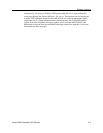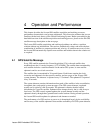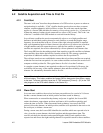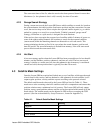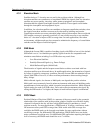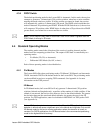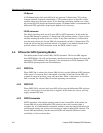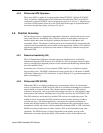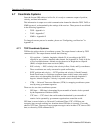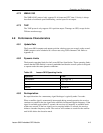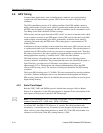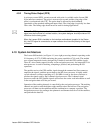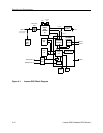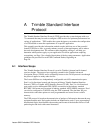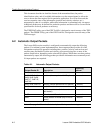
Lassen-SK8 Embedded GPS Module 4-7
Operation and Performance
4.5.4 Differential GPS Operation
The Lassen-SK8 is capable of accepting and decoding RTCM SC-104 data. RTCM SC-
104 is an industry standard protocol for differential correction data. The Lassen-SK8 is
configured to accept RTCM SC-104 correction data over Port 2 (J4, pin 7). Alternatively,
you can use TSIP packets 60 and 61 or the TAIP and DD messages to input differential
corrections through the primary serial port (J4, pin 5).
4.6 Position Accuracy
GPS position accuracy is degraded by atmospheric distortion, satellite and receiver clock
errors, and Selective Availability (SA). Effective models for atmospheric distortion of
satellite signals have been developed to minimize the impact of tropospheric and
ionospheric effects. The impact of satellite clock errors is minimized by incorporating the
clock corrections transmitted by each satellite used in the position solution. SA is the most
significant contributor to position error and cannot be effectively combated except with
differential GPS.
4.6.1 Selective Availability (SA)
The U.S. Department of Defense, through a program called Selective Availability,
intentionally degrades GPS accuracy for civilian users. The SA program creates position
errors by modifying the apparent position of each satellite and introducing random dither
into each satellite's clock.
In extreme cases all sources of error (natural, PDOP, and SA) can combine to produce
large position errors. The DOD's definition of accuracy under SA is 100 meters 2 dRMS
(horizontal 2 dimensional, 95% of the time). In April 1996, the U.S. government approved
plans for disabling SA.
4.6.2 Differential GPS (DGPS)
Differential GPS is an effective technique for overcoming the effects of SA and other
sources of position error. DGPS relies on GPS error corrections transmitted by a reference
station placed at a known location. The reference station compares its GPS position
solution to its precisely surveyed position and calculates the error in each satellite's range
measurement. The industry standard protocol for GPS correction data is RTCM SC-104.
The GPS corrections are broadcast to mobile GPS receivers in neighboring areas. The
mobile receivers incorporate the GPS corrections in their position solution to achieve
excellent accuracy. For marine applications, corrections are typically modulated on
marine radio beacon broadcasts. For land-based applications, the correction data can be
transmitted over FM sub-carrier, cellular telephone or dedicated UHF or VHF radio links.
DGPS can reduce position error to under 5 meters, 95% of the time under steady state
conditions. The DGPS accuracy is highly dependent on the quality and age of the
differential corrections and the proximity of the mobile receiver to the reference site.



